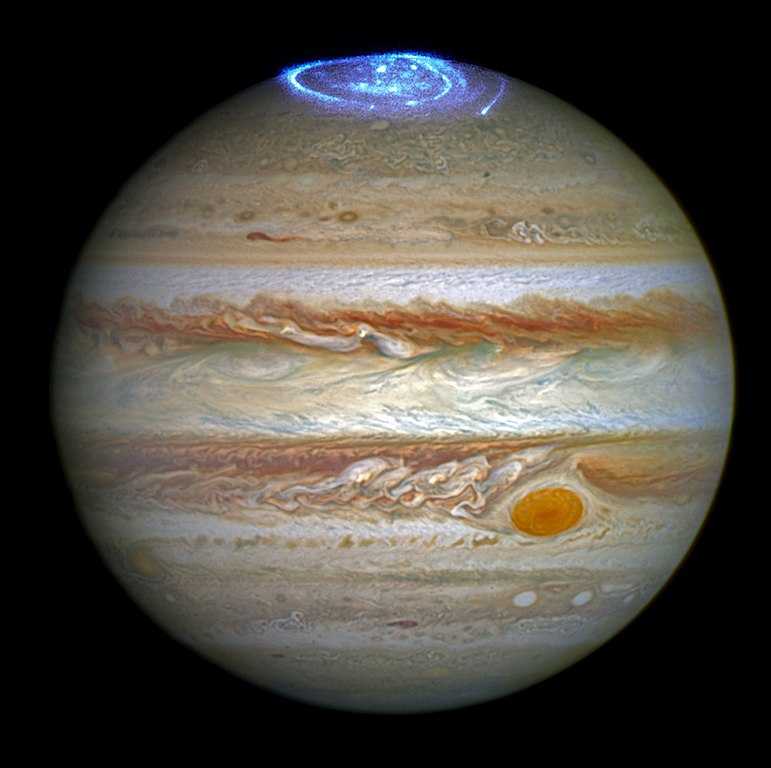In this article we give you a variety of facts about the planet Jupiter
Jupiter is the fifth planet from the Sun and the largest in the Solar System. It is a gas giant with a mass one-thousandth that of the Sun, but two and a half times that of all the other planets in the Solar System combined.
Jupiter is the third brightest natural object in the Earth’s night sky. It is named after the Roman god Jupiter.
Jupiter is primarily composed of hydrogen, but helium comprises one quarter of its mass and one tenth of its volume. It likely has a rocky core of heavier elements, but lacks a well-defined solid surface.
Because of its rapid rotation, the planet’s shape is that of an oblate spheroid; it has a slight but noticeable bulge around the equator. The Great Red Spot is a prominent feature which is a giant storm that is known to have existed since at least the 17th century.
Surrounding Jupiter is a faint planetary ring system and a powerful magnetosphere. Jupiter has almost a hundred known moons and possibly many more, including the four large Galilean moons. Ganymede, the largest of these, has a diameter greater than that of the planet Mercury.
Jupiter Facts
Jupiter is the largest planet in our solar system.
It is the fifth planet from the sun.
It is made up mostly of hydrogen, and a smaller percentage of helium.
Some people believe its a failed sun.
The atmosphere is made out of ammonia, sulfur, methane, and water vapor.
Jupiter does not have a very well-defined surface.
The planet was named after the king of Roman gods, Jupiter.
There is a ring system around Jupiter but it is faint.
The mass of Jupiter equals 2.5 times the mass of all other planets in our solar system combined.
Jupiter is often the fourth brightest object in the sky.
Jupiter weighs 1,898,130,000,000,000,000 billion kg.
This equals 318 times earth’s mass.
Jupiter’s circumference is 439,264 km.
Jupiter’s diameter is 11 times the size of earths.
Jupiter has a mean radius of 69,911 kilometers.
Jupiter has a diameter at the equator of around 142,984 km.
Jupiter has a diameter at the poles of 133,708 km.
The first recorded sighting of Jupiter were by the ancient Babylonians.
One orbit of the Sun takes Jupiter 11.86 Earth years.
Jupiter is the fastest rotating planet in our solar system.
Its days are only 10 hours long.
Jupiter is on average about 5.2 AU away from the Sun.
Jupiter experiences 200 times more asteroid and comet impacts than Earth.
Jupiter has at least 67 moons around the planet.
The largest of Jupiter’s moons, Ganymede is the largest moon in the solar system.
The moons are sometimes called the Jovian satellites.
The largest of them are Ganymede, Callisto, Io and Europa.
Ganymede is larger than the planet Mercury.
An object that weighs 100 pounds on earth would weigh 264 pounds on Jupiter.
The surface temperature on Jupiter is -108 degrees Celsius.
Jupiter has a very strong magnetic field.
The Great Red Spot is a huge storm on Jupiter.
It has lasted for at least 350 years.
It is so large that the planet Earth could fit inside it.
Jupiter’s radiation can be detected here on earth.
Eight spacecraft have visited Jupiter so far.
Jupiter generates more heat than it receives from the Sun.
The moon Io is the most volcanically active body in the Solar System.
The moon Europa may have water on it under a layer of ice.
Jupiter does not experience seasons like other planets such as Earth and Mars.
Jupiter has an Aurora which appear to be an electric blue color.

